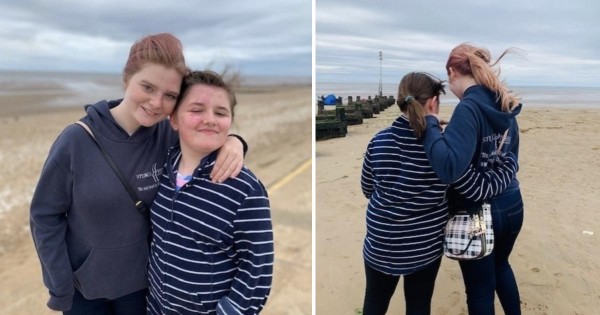2 Girls With Limited Mobility Walk 198 Miles to Raise Funds for Charity That Helped Them as Babies

Caity Downs, 19, and Angelina Mills, 11, from Gresham in Norfolk, took a 198-mile walk (the distance between their homes) to raise funds for Sturge Weber UK.
Both of these girls suffer from Sturge Weber Syndrome (SWS), but despite having minimal movement on one side of their bodies, they challenged themselves to do this for the charity that has been there for them since they were babies.
Despite the lockdown imposed, the girls challenged themselves to continue to stay positive by raising awareness and funds for their condition.
So far, the girls have surpassed their fund-raising target of £1,250 and manage to raise £6,001.
Due to the effects of COVID-19, the charity has lost a lot of funding and needs support now more than ever.
On September 1, the girls completed the momentous final mile in Brighton. Karen Emanuel, CEO of Key Production, and local business owner who is based at 85 Gloucester Road, Brighton, was so inspired by the girls' "strength in adversity," that she organized a trip for the girls up the i360 Viewing Point before the school holiday is over.
View this post on Instagram️We are proud to be supporting such a heart-warming story about two girls aged 11 & 19 (Angelina from Norfolk & Caity from Brighton) who have Half A Brain and are walking 198 miles to raise awareness for Sturge Weber UK charity - #sturgeweberuk. The girls will walk the final mile together in Brighton on Tuesday 1st September between 1pm-3pm (weather depending), finishing with a trip up the British Airways i360 Viewing Tower, courtesy of local business, @key_production. If this sounds of interest, please do get in touch our Curious PR team on hannah@curiouspr.com or jess@curiouspr.com. If you would like to donate, please click the link in bio. @karenemanuel1 #charity #prrequest #sws #sturgeweber #syndrome #keyproduction #music #karenemanuel #supporting #support #localnews #norfolk #brighton #devon #challenge #walkingchallenge #walk #disability #awareness #funds #raisingfunds #covidchallenge A post shared by Curious PR (@curiouspr) on Aug 27, 2020 at 6:00am PDT
WOW: 103-Year-Old Retired Doctor Walks Month-Long Marathon to Fund COVID-19 Research
What is Sturge Weber Syndrome?
Sturge Weber Syndrome, also known as encephalotrigeminal angiomatosis, is a neurocutaneous disorder that is usually marked with a distinctive birthmark somewhere on the face—port-wine stain. This stain is caused by an overabundance of capillaries near the surface of the skin.
To be diagnosed with SWS, both port-wine stain and abnormal blood vessels in the brain on the same side as the stain must be present.
This is a rare condition that occurs in between 1 in 20,000 to 1 in 50,000 live births and develops most often during the first 3-4 months of pregnancy.
Around the sixth week of pregnancy, a network of nerves develops around the area that will become a baby's head. Typically, this goes away during the ninth week of development. However, for those born with SWS, this network of nerves doesn't go away, impeding the amount of oxygen and blood flow to the brain than can affect brain tissue development.
Common disabilities associated with SW are epileptic seizures, hemiplegia (weakness on one side of the body, similar to that of a stroke), and learning difficulties. There may also be ophthalmic manifestations like increased pressure in the eye (glaucoma), which, if not treated, may result in vision loss or blindness. Symptoms usually occur in the child's first year of life.
Not everyone with a port-wine stain has SWS, but all children with SWS have a port-wine stain.
Treatment for SWS
Treatment varies depending on the severity of symptoms experienced by the child. It may consist of anticonvulsant medication to decrease seizure activity, eye drops, or surgery to relieve eye pressure, physical therapy for improvement of muscle strength, and educational therapy to help those with developmental delays.
Laser treatment may also be done to lighten or remove the birthmark. However, the stain may come back again. Currently, doctors are using a topical application known as sirolimus to help prevent the capillaries from growing back.
LOOK INTO: Coronavirus Lockdown Has Led To More Cases of Domestic Violence
Check out more news and information on Neurology on MD News Daily.
Sep 07, 2020 11:41 PM EDT





